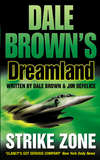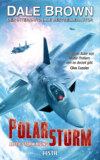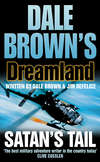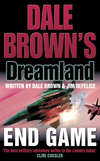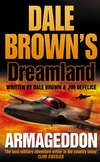Buch lesen: «Strike Zone»
DALE BROWN’S DREAMLAND
Strike Zone
WRITTEN BY DALE BROWN AND JIM DEFELICE

Contents
Cover
Title Page
I Ghost Clone
II Paradise
III Chips
IV Duty
V Vaporized
Epilogue: Heroes, after a Fashion
About the Author
Also by the Author
Copyright
About the Publisher
I
Ghost Clone
Bright Memorial Hospital, Honolulu 3 September 1997, 0302 (all times local)
It looked like an arrow as she turned to get away from it. Breanna pushed hard on her control stick, but the plane barely responded. Caught with little forward momentum, the Megafortress waddled in the air, finally managing to jerk its nose back to the right just in time to avoid the missile.
A second and third homed in. Breanna Stockard put her hand on the throttle slide, desperate to get more speed from the power plants.
It was too late. She could see one of the missiles coming at her right wing, riding the air like a hawk. Bree had ECMs, flares, tinsel – every defensive measure the experienced Megafortress pilot could muster was in play, and still the hawk came on, talons out.
And then, just as it was about to strike the fuselage in front of the starboard wing root, it changed. The slim body of the Russian-designed Alamo missile thickened. Wings grew from the middle, and the steering fins at the rear changed shape. Breanna was being tracked by an American Flighthawk, not a missile. For a moment, she felt relief.
Then the robot plane slammed into the wing.
Breanna shook herself awake. The pale green light of the hospital room threw ghost shadows across her face; she could hear the machine monitoring her heartbeat stuttering.
‘Damn drugs,’ she said.
They’d given her a sedative to help her sleep, fearful that her injuries would keep her from resting for yet another night. Breanna had bruised ribs, a concussion, a sprained knee, and a twisted neck; she was also suffering from dehydration and the effects of more than twelve hours exposure to a bitter Pacific storm. But the physical injuries paled beside what really ached inside her – the loss of four members of her crew, including her longtime copilot Chris Ferris and Dreamland’s number two Flighthawk pilot, Kevin Fentress.
Breanna rolled onto her back and shoved her elbows under her to sit up in the bed. She was angry with herself for not flying better, for not avoiding the Chinese missile that had taken her down. The fact that she had sacrificed her plane to rescue others was besides the point. The fact that the Piranha mission had been a stunning success, averting war between China and India, mattered nothing to her, at least not now, not in the room lit only by hospital monitors.
She should’ve saved her people.
Her father would have. Her husband would have.
She ached to have them both here with her. But her father, Colonel Tecumseh ‘Dog’ Bastian, and her husband, Major Jeff ‘Zen’ Stockard, had been called back to Dreamland, to deal with problems brewing there. She was sentenced to sit in this bed until her injuries healed.
‘Damn drugs,’ she muttered again, reaching for the control at the side of the bed to raise it.
What the hell had that stupid dream been about? She’d been taken down by a missile, not a Flighthawk. The Flighthawks were US weapons, not Chinese.
But as they were going down, before she gave the order to abandon ship, Torbin Dolk had said something about a Flighthawk. What the hell had he said?
‘I have a U/MF at long range.’
Those were his words, but they had to be wrong. Their own Flighthawks had been lost, and there were no other Megafortresses with their robot scout fighters nearby.
What the hell did he say? Had she got it wrong?
The confusion and static and storm of the shoot-down returned. She closed her eyes, wishing she hadn’t failed.
‘Damn drugs,’ she said, playing with the bed control in a fruitless effort to make herself more comfortable.
Outside Taipei, Taiwan 1700
Chen Lee waited until the chime of the antique grandfather clock at the far end of his office ended, then rose slowly from his desk, following a ritual he had started many years before. His movements were weighted by eighty years of exertion, and so it took longer for him to cross the large office than it once had, but the familiarity of the afternoon ritual filled him with pleasure. He had long ago realized that, no matter how much wealth one had – and he had a great deal – the more important things, the things that gave life meaning and value, were less tangible: family affection and respect, dreams and ambitions, ritual.
Chen Lee went to the chest at the right side of his large office and took the bottle from the top, carefully pouring two fingers’ worth of Scotch in the glass tumbler. He had developed a taste for single-malt Scotch as a young man during the last days of the war with the communists when he’d been sent to London as part of a delegation working to persuade the Western allies that Mao must be stopped at all costs. The mission had been a failure; worn out by the World War, the British couldn’t stop their own empire from slipping through their fingers, let alone send an army to help Chiang Kai-shek and the rightful rulers of the great Chinese nation. Not even the Americans were willing to help them until the communist treachery was made obvious in Korea. Even then, the only assistance they would begrudgingly afford was to prevent the invasion of Taiwan by the mongrel bastards who had marched among the peasants, pretending moral superiority when all along practicing opportunism.
The tingle of Scotch as he took his first sip reminded Chen Lee of his bitterness, and he welcomed it wholeheartedly. For it was only by acknowledging the past that he could look toward the future.
Much had changed in the nearly fifty years that had passed since his stay in London. Chen Lee had left the government to become a man of business; he had started humbly, as little more than a junk man. He took discarded items, first from the Japanese, then from Europe and the US, and turned them into useful materials. Metals first, then gradually electronics and chemicals and even, eventually, nuclear materials. He had made a fortune, and then lost much of it – a loss he blamed on the treachery of the Japanese he was forced to deal with in the early 1980s. But this loss had tempered him; he would not willingly wish it upon anyone else, but he had managed to overcome it, and applied its lessons well.
His assets now totaled close to a billion dollars US; he owned pieces large and small of businesses throughout the world as well as the Republic of China – Taiwan to the outside world. In fact, his wealth was so extensive he needed two of his three grandsons – his only son had died more than a decade before – to manage it. They were given relatively free hands, as long as they did not break his cardinal rules: no investment in Japan, and no dealings with the communist mongrels under any circumstances.
Others on the island were not so fastidious, and in their eagerness to enrich themselves had prepared the nation for the ultimate treachery – surrender to the communists.
It was coming. Several months before, the provinces had clashed. At first, the Americans had seemed to help them; Mainland bases were bombed in a spectacular campaign referred to by the media as ‘Fatal Terrain.’ Had the war proceeded then, reunification might have been possible. But the Americans had proven themselves interested only in preserving the status quo. Worse, the government on Taiwan – the rightful representatives of all China, in Chen Lee’s view – lost face and gave way to a group of men who could only be called appeasers. In a matter of weeks, the president was due to fly to Beijing for talks with the mongrels who had usurped the homeland.
The meeting would be the first of many.
Chen Lee was determined not to let it take place. He was willing, in fact, to spend his entire fortune to stop it.
He was willing to go further. He would give his own life so that his grandchildren’s children might once more live freely in their homeland.
Was he willing to give their lives as well?
The Scotch burned the sides of his tongue.
He was willing to let them die, yes. Even his favorite grandchild, Chen Lo Fann. Indeed, Fann had volunteered to do so many times already.
Would he give up the lives of his great-grandchildren, the sweet little ones?
As he asked the question, he saw the faces of the little ones, whose ages ranged from two to ten.
No, he would not wish any harm to them, boy or girl. That was why he must act immediately.
The Americans had interfered, preventing what should have been a war between the communists and India – a war he had clandestinely encouraged.
Chen Lee took another sip of his drink. He had to encourage a wider war, one that would involve all of South Asia and the mongrels. Even if the war did not lead to conquest of the stolen provinces, it would at least halt the present slide toward accommodation.
It might yet yield conquest, thanks to the weapons he had developed and secreted away. But he felt he could not share them with the present government, headed as it was by traitors. He would have to follow his own path.
Chen Lee was bitterly disappointed in the Americans, whose ill-considered attempts at imposing peace merely made the world safe for the mongrel usurpers. During the course of his life, Chen Lee had had many dealings with Americans; he admired them in many ways. But ultimately, he found them weak and undisciplined.
He knew too that their aims were not his aims. They protected the Republic of China only when it suited them.
So be it. If the Americans intervened again, their blood would flow.
Air Force High Technology Center/Whiplash Complex (aka Dreamland) 4 September 1997, 0700
Jennifer Gleason pushed back a strand of her long hair and leaned forward, her nose nearly against the large flat panel of the computer display, as if close proximity to the line of code might reveal more detail.
The line itself was abstract and seemingly meaningless:
AAA488570C6633CO2222222222BCO354777
But to the computer expert, the gibberish told an ominous tale. She picked up the pencil she had laid on the desk nearby, twirling it in her finger before copying the line on a yellow pad nearby.
‘Pad and pencil – never a good sign,’ said an acerbic voice behind her.
‘Hi, Ray,’ she said before double-checking her copy against the screen.
‘Well?’ Dreamland’s senior scientist Ray Rubeo stood over her, squinting down at the screen.
‘Our compression algorithm.’
‘Yes,’ said Rubeo.
‘It doesn’t prove anything. The algorithm itself could have come from a bunch of places.’
Instead of answering, Rubeo stooped to the workstation next to her, quickly tapping a pair of keys and bringing up a small snippet of video. A gray shadow of an aircraft banked and turned away in the screen.
The image had been built from a fleeting radar contact made several days before in the South China Sea, during a bloody battle between the Chinese and Indian navies. A Dreamland Megafortress called Quicksilver had tried to stop the conflict, and in the process had been shot down. Four of the six crew members aboard had died.
Quicksilver, with the help of other Dreamland air and ground assets known collectively as Whiplash, had forestalled a nuclear confrontation between the two Asian powers and saved millions of lives. Four lives for a million. Most people would think that a worthwhile trade-off.
The equation was difficult when it involved people you knew. Jennifer, one of the top scientists at the facility, knew all of them very well. She was thankful at least that the pilot, Breanna Stockard, had been spared. Bree was her lover’s daughter, and while the two women had never gotten along particularly well themselves, Jennifer could not have borne the hurt Bree’s death would have caused the colonel.
Jennifer watched as the three-dimensional blob reappeared in the right-hand corner of Rubeo’s screen, commanded to reappear by Dreamland’s senior scientist. It twisted and jerked left, then down and over to the opposite corner of the screen. The simulation multiplied real time by a factor of twenty, so that the blob stayed on screen for an entire minute, rather than the three seconds it had appeared on the original radar.
Those three seconds, along with the five seconds’ worth of radio transmission Jennifer was studying on her own terminal, were enough to have cost both her and Rubeo several days’ worth of sleep. For together they meant there had been another unmanned robot plane in the air about seventy-five miles from the Megafortress when it was shot down.
And not just an ordinary ‘robot,’ or unmanned aerial vehicle, commonly known as a UAV. The experts interpreted the poor quality of the radar returns to indicate that the tiny aircraft was faceted much the way first-generation Stealth fighters were; the blanks in the simulation that made the plane jerk across the screen were a function of weak or missing radar returns. The experts had also determined that the craft had been going somewhere around 400 knots and took a turn sharp enough to pull close to ten g’s.
Designing and building a small aircraft – its wingspan appeared to be under ten feet – was certainly difficult, but the real achievement was controlling the robot. To make it fly and maneuver in real time took considerable skill, skill that until now had resided only at Dreamland. While there was a variety of UAVs around, most flew preprogrammed courses or went relatively slowly. Only the U/MF-3 Flighthawks developed at Dreamland were capable of high-speed maneuvers and aerial combat.
Imitation might be the highest form of flattery, but in this case it could also be deadly. Properly handled, the U/MF-3s were almost impervious to American defenses. If the ghost clone – one of the techies had named it that while reviewing the radar and telemetry intercepts – was armed, no part of the country would be safe.
‘So whose is it?’ asked Rubeo, voicing the question of the hour.
‘Could be a Russian project,’ offered Jennifer.
‘Yes,’ murmured Rubeo. ‘It’s possible.’
‘And they stole it two years ago.’
‘The intelligence assessments would have shown this,’ said Rubeo. Dreamland had been rocked two years earlier when a deeply planted Russian spy was exposed. He had compromised some of the facility’s top projects, and in many ways Dreamland had never been the same. But he had no access to the Flighthawk project, as an extensive investigation had proven.
So if the technology had been stolen, someone else had done it.
Someone still working at the base.
Rubeo stood back from the screen.
‘Our code or not?’
‘Very close,’ said Jennifer. ‘It uses similar theories and compression schemes.’
‘So what does it mean?’
Jennifer pointed to the first few integers. The code was in base sixteen. ‘It’s detecting the radar, giving a position, tagging the type, and then I think this part confirms a maneuver it’s already started on its own.’
‘Still think it’s a coincidence?’ Rubeo asked her.
‘Mmm,’ she said. ‘It could be.’
‘The memorial service is in half an hour,’ he told her. Then he walked from the room.
Colonel Tecumseh ‘Dog’ Bastian looked out at the apron in front of Dreamland Hangar Two. A half-dozen temporary bleachers had been erected in front of the building; augmented by a sea of folding chairs, they held a good portion of the men and women he oversaw at the hightech developmental base in the wastelands near Glass Mountain, Nevada. In front of the bleachers was a podium; off to the side, a short row of folding chairs. In a few minutes, an honor guard would appear from the building for a ceremony commemorating a recently concluded operation in the Pacific. Some of the people back at the Pentagon called the action ‘the Piranha Incident’ because of the undersea surveillance weapon Dreamland had used during it; to Dog, the nickname was appropriate for its bloody connotation – the operation had been a man killer. Five members of Dreamland had lost their lives during it: four when a Megafortress was shot down by an errant Chinese missile; the fifth had stepped on a mine during a support operation.
Ostensibly, the ceremony that was about to kick off would honor the living – the President had issued a special, albeit secret, unit commendation to Dreamland, which would be read by the President’s representative, NSC assistant director for technology, Jed Barclay. But for Dog and most of the people attending, the ceremony was mostly about the men who had lost their lives.
It was something of a cliché to refer to military commands and bases as families. In many cases, it wasn’t a very accurate description – thousands and thousands of men and women might work at a typical base. The majority would have little contact with one another outside of their assignment area. But Dreamland was different. Ostensibly part of Elliott Air Force Base, the home of the High Technology Aerospace Weapons Center, Dog’s command was an ultra-secret and relatively small unit contained at facilities adjacent to the main base. Dreamland didn’t just make the country’s next-generation weapons; they tested them in combat under an ops program known as Whiplash, which answered to the President through the National Security Council. Whiplash was Dog’s brainchild.
Only a few hundred people worked here, and the majority lived here as well. Not only did civilian experts mix freely with military personnel, service people of all ranks worked together in as close to harmony as the high-pressure, creative atmosphere would allow. The cafeterias, lounges, and rec areas were ‘all ranks,’ open to everyone who worked at Dreamland, from Dog all the way to the kitchen help. Pilots still ruled the roost – it was, after all, an Air Force operation – but, with a few notable exceptions, the zippersuits kept their egos well in check.
Partly, that was a function of whom they worked alongside. Everyone here was the best of the best. The ordies loading missiles to be tested on a plane were likely to have helped design and build the weapon. And partly, it was a reflection of Dog’s own personality, and his desire to run a cutting-edge operation that made a difference, not just for America, but for the world.
Dreamland had done that, as Piranha proved. But it had also paid a terrible price.
The loudspeaker near the side of the bleacher blared with a solemn martial tune. The colonel stiffened, waiting for the honor guard that just now emerged from the building. He glanced at the bleachers, where everyone had suddenly snapped to attention. Despite the solemnity of the occasion, the scene brought a smile to his lips – not only were all of Dreamland’s military personnel wearing freshly starched uniforms, but the civilian scientists, engineers, and other technical experts were wearing their own Sunday best – suits and dresses.
Dresses!
Ties!
These were as rare a sight at the top-secret base as any Dog could imagine.
The colonel fell in, his legs a little rusty as he marched to his place at the front. He was joined by the Reverend Madison Dell, Dreamland’s chaplain, and two other members of his staff: Major Natalie Catsman, who had just been named second in command at the facility, replacing Nancy Cheshire, who had recently been given new responsibilities integrating the Megafortress in the regular Air Force; and Captain Danny Freah, who besides being the head of base security also commanded the Whiplash ops team, the ground force charged with providing security and ground intervention in connection with Dreamland deployments.
After a brief prayer, Dog stepped forward. He’d worked on his speech for several hours the night before, carefully revising and rewriting it over and over again. But now as he walked to the microphone, he decided not to take it from his pocket.
‘I don’t have a lot to tell you,’ he said simply. ‘You’ve done a good job, and I know you know that. I also know that, like me, you’re hurting today, because of our friends who aren’t here. Unfortunately, that’s part of our business – it’s part of our lives. I hate it myself …’
Captain Danny Freah stared into the distance as Dog began to read the President’s commendation. He was thinking of the man he’d lost to a booby trap, Sergeant Perse ‘Powder’ Talcom. Powder was a hell of a team sergeant, a hell of a serviceman, a hell of a hero. The two men had been together since Bosnia, coming under fire several times. Like any good officer, Danny drew a line between command and friendship, duty and camaraderie. And yet, Powder’s loss affected him in ways he couldn’t fully explain. Dog had offered him the chance to talk at the ceremony; Danny had begged off, claiming he wasn’t much of a talker.
The real reason was that he could never have hidden the tremor in his voice, or stopped the tears from falling.
Powder’s death had convinced him that he should take an offer to run for Congress back in New York, where his wife lived. To do that, he’d have to leave the Air Force.
Dog had asked him to stay on for a short while. The ghost clone business had to be investigated by someone the colonel trusted, and the job naturally fell to Danny.
But he would quit when it was done.
Quit? Was he walking away?
No. His time was up; he’d done his duty. He could leave.
Quit.
The reverend stepped forward and gave a reading from Isaiah, his text the famous line about beating swords into plowshares. It was appropriate in a way – Dreamland’s efforts had saved many lives, and given the diplomats a shot at turning China and India from their warlike ways. But Danny couldn’t help thinking that no text about peace would ever be truly appropriate for a warrior, certainly not a member of the Whiplash team. Peace was an unfulfilled promise, a mirage that sucked you in. As soon as you dropped your guard, disaster would strike.
As it had with Powder, stepping on the mine.
My fault, thought Danny. My inattention cost my man his life.
My fault.
A solitary tear slipped from the corner of his eye.
As the minister ended his sermon, recorded music began to play through the speakers. As it grew louder, a slightly discordant bass note could be heard rising over the violins like an extended rap note coming from far away. A Dreamland formation suddenly appeared from the desert floor, seeming to rise from the mountains themselves.
The first plane over was an EB-52 – black, huge, and thunderous, a Megafortress similar to the one Dreamland had lost in the South China Sea. Born as a Boeing B-52 Stratofortress, the airframe had pounded communists in Indochina and stood alerts against Soviet bomber strikes, then gone on to serve a long and respected career as a testbed, launching drones and missiles.
Just when it seemed ready to retire, the Dreamland wizards had tapped the thirty-year-old soldier for refurbishment. It had been taken into a large hangar and stripped naked, most of its parts dismantled. New wings made of ultra-strong composite were added; the rear tail and stabilizer assembly was replaced with a V-shaped unit affording more maneuverability and somewhat less radar profile. The eight power plants were replaced with four Dreamland-tuned monsters that could drive the aircraft nearly to the speed of sound in level flight, yet were as easy on gas as a well-tuned Honda.
The wires and circuit boards that had made up its avionics systems were salvaged and recycled for other B-52s; their replacements were fiber optic and galliumarsenic, silicone, and in several cases custom-grown crystal circuitry. Besides the equipment that helped the pilot fly the aircraft through a hostile-fire zone, this particular EB-52 – nicknamed Raven – was stocked with an electronics suite that would have made an NSA officer’s eyes water. It could capture a wide array of electronics signals, everything from encoded radio transmission to missile telemetry and even, as some of the Dreamland wags put it, the odd leak from a microwave oven. Besides monitoring those signals, Raven could use its on-board circuits to confuse and baffle a wide range of radars, providing cover for a fleet of other aircraft.
Raven’s bomb bay had been overhauled so that its rotating dispenser could launch (or drop) a variety of smart weapons – not just bombs and air-to-ground missiles, but AMRAAM-plus antiaircraft missiles. At its tail, the four 12.7 or 50-caliber machine guns had been replaced by a Stinger airmine gun, which could pepper the sky behind the plane with exploding shards of tungsten, just the thing to shred a jet engine and ruin a pursuing fighter pilot’s day. While no match for a frontline American interceptor, the Megafortress could hold her own when attacked by most enemies – as this one had done on several occasions.
Next over the Dreamland apron area was a heavily customized C-17, the product of an intense collaboration between Dreamland and the highly skilled engineers at McDonnell Douglas further enhancing its already impressive heavy-hauling and short-runway abilities. Dubbed the MC-17D/W-2, the black-skinned aircraft sported two belly blisters, which in time would be filled by specially designed howitzers. According to the concept, the aircraft would be able to drop two companies of Marines and then provide fire support a la the AC-130, combining two functions in the same aircraft. The weapons had not yet been fitted to the plane; they were due to be tested in about two weeks. The guns, as awesome as they were, were just a start – a team was hard at work trying to make enough adjustments to the Razor antiaircraft laser so that it could be used in place of the howitzers.
As the big plane came over, she dipped her left wing, a nod to the fallen comrades being honored at the ceremony below. Not far behind the MC-17 came an F-22. Like every aircraft at the high-tech developmental center, the Raptor’s airframe had undergone extensive revamping. Now longer, it sported a delta-shaped airfoil and sabertoothed tiger strakes at the front; the design was being studied for possible use as an F-15E replacement.
Last but not least in the Dreamland formation was a B-1B, the swing-wing, Mach + attack craft that had once been seen as the B-52’s replacement, though the versatile Stratofortress had refused to be pushed aside. The big wings of the Lancer – sometimes dubbed the ‘Bone’ by her crew, a pun on B-One – were fully extended, allowing the aircraft to parade over the grounds at a low and solemn speed.
This aircraft had been used to test some concepts for the Unmanned Bomber project; its four GE F101 engines had only recently been returned to their place under the wing roots and fuselage, reclaiming their position from hydrogen-powered prototypes that would be the main impetus for the UMB. Immediately after the ceremony, the B-1 would head for Underground Hangar Five, where she would begin a new phase, testing a concept as an advanced penetrator/weasel equipped with antiradar HARM missiles and a multiple mini-bomb launcher.
As the B-1 climbed away, a second group of aircraft, these much smaller, appeared from the right. Four U/MF-3 Flighthawks thundered by in a diamond pattern. Just as they reached the center of the viewing area in front of the stands, one of the aircraft peeled off; the others circled around the field, commemorating the loss of Dreamland’s fallen comrades. Smoke canisters under the fuselages of the remaining aircraft ignited, and the sky turned red, white, and blue. The Dreamland audience rose to their feet as one, saluting their comrades and pledging themselves once more to the cause of keeping America free and the world safe.
Danny stared into the distance, back teeth tightly clenched.
